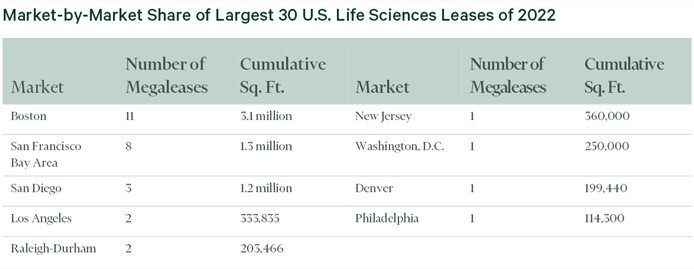Commercial Real Estate News

Largest Life Science Leases of 2022 Mainly in San Diego, San Francisco and Boston
Commercial News » San Diego Edition | By Monsef | April 4, 2023 8:22 AM ET
According to a new report from CBRE, several metrics point to the U.S. life sciences industry and the real estate that houses it proving resilient during the current economic slowdown. Among those factors: a growing total of clinical trials for new drugs, persistent job growth, more federal funding, and ample cash reserves for the industry's larger companies.
These factors and others will influence the rapidly growing market for life sciences real estate. CBRE forecasts that cumulative square footage of lab space in the largest 13 U.S. life sciences markets, already having expanded by 47% in the past five years, will increase by another 22% within the next two years to 220 million sq. ft. as projects currently under construction are completed. Nearly a third of that space under construction is pre-leased.
That's not to say the life sciences sector is immune to the economic slowdown. Recent turmoil in the banking sector is likely to hamper venture capital funding this year for startup life sciences and tech companies. Initial public offerings by life sciences companies have fallen off. Job growth for life sciences professions slowed to a 4.1% gain in January 2023 from 6.4% a year prior. And U.S. lab vacancy rose to 5.7% in last year's fourth quarter from 5.1% in the third, though it remains low relative to many other real estate sectors.
Increase in Clinical Trials
Other indicators, especially in drug discovery and development, point to more growth for life sciences. Globally, the number of clinical trials increased to 444,567 by March 2023, up 36% from 2020, according to the U.S. National Library of Medicine. In the U.S., the number of new Phase 2 and 3 clinical trials - when life sciences companies most often expand their operations - ramped up over the past decade to exceed 3,000 in each of the past three years.
"The life sciences industry and the broader economy have hit choppy waters in recent months, but the industry's most important gauge - the product pipeline - signals sustained, underlying growth," said Matt Gardner, CBRE's Americas Life Sciences Leader. "Many metrics have receded from their 2020 and 2021 highs, but they're still above their pre-pandemic levels. There is a lot of promising science in the works to propel this industry forward once the lending environment settles."
Additional indicators: Annual funding from the National Institutes of Health has risen by 62% in the past decade, including an increase to $47.5 billion this year from $45.2 billion last. And U.S. life sciences companies had a cumulative $200 billion in cash reserves last year, a decline from the previous three years but still higher than 2018 and before. That capital could be a resource for mergers and acquisitions of smaller biotech companies.
Real Estate Impact
Despite these tailwinds, lab vacancy is likely to rise further in many markets due to new construction.
"Greater availability of lab space will provide relief for occupiers in markets like Boston, the San Francisco Bay Area, and San Diego, where available space has been scarce for many years," said Ian Anderson, CBRE Senior Director of Research.
CBRE's report includes an analysis of the largest 30 U.S. life sciences leases of 2022, illustrating a concentration of big leases in the traditional life sciences hubs but also several in additional markets.
Sign Up Free | The WPJ Weekly Newsletter
Relevant real estate news.
Actionable market intelligence.
Right to your inbox every week.
Real Estate Listings Showcase
Related News Stories
Commercial Real Estate Headlines
- U.S. Commercial Mortgage Delinquencies Rise in Q2, CMBS Loans Lead the Surge
- Tokenization-Focused Real Estate Investment Bank Announced
- Commercial Cap Rates Edge Lower in U.S., Hinting at Market Turn
- WPV Targets New $6 Trillion Digital Real Estate Tokenization Opportunity
- $1 Trillion in Data Center Development Underway Through 2030
- WORLD PROPERTY VENTURES: The 'Anti-VC' of Real Estate Plans Major Capital Raise
- Multifamily Sector Enjoys Record Absorption in U.S. as Supply Slows, Vacancies Drop
- Employee Back-to-Office Attendance Surges in U.S.
- Phnom Penh Commercial Property Sectors Face Crosswinds in 2025
- World Property Bank Announced to Capitalize on Coming Trillion-Dollar Tokenization Boom
- REAL ESTATE PREDICTIONS: Decentralized Events Contract Exchange in Development
- U.S. Architecture Billings Improve Slightly in May
- Tokyo Office Demand Spills into Non-Core Wards in 2025
- AI Hyperscalers Drive Record Data Center Leasing in Early 2025
- Commercial, Multifamily Mortgage Debt in U.S. Hits Record $4.81 Trillion in Early 2025
- U.S. Multifamily Market Rebounds in Early 2025
- U.S. Office Market Experiences Historic Conversion Shift
- New York City Enters New Era of Office-to-Residential Conversions
- World Property Ventures Plans New Capital Raise
- U.S. Commercial Real Estate Lending Rebounds Sharply in Early 2025
- U.S. Multifamily Housing Confidence Declines in Early 2025
- Asia Pacific Commercial Investment Holds Steady in Early 2025
- Carnival Plans New Miami Headquarters Spanning Over 600,000 Square Feet
- Hong Kong Property Investors Take a Wait-and-See Approach Due to U.S. Tariffs
- U.S. Multifamily Buyer and Seller Sentiment Improves in Early 2025
- One Trillion Dollars of America's Commercial Property Loans Mature in 2025
- U.S. West Coast Dominates Self Storage Demand
- Phoenix, Orange County and Inland Empire Emerge as Leading U.S. Industrial Markets
- U.S. Mega Distribution Centers Leasing Activity Grew in 2024
- U.S. Commercial Borrowing to Increase to $583 Billion in 2025, Up 16 Percent Annually
- Demand for U.S. Life Sciences Space Spikes 28 Percent Annually in Late 2024
- Multifamily Property Sector in America Rebounding
- Asia Pacific Commercial Property Investment Spikes 23 Percent in 2024
- U.S. Commercial Property Market Primed for Growth in 2025
- Architecture Industry Sees Mixed Signals as 2025 Approaches
- Global Data Center Demand Spikes in 2025
- 2025 Prediction: U.S. Commercial Investment Recovery Expected to Gain Traction
- Holiday Retail Sales for 2024 to Hit Record $1 Trillion
- Tech, AI Industries Drive Largest Share of Office Leasing Activity in U.S.
- Commercial Real Estate Lending in U.S. Enjoys Strong Growth in Q3








